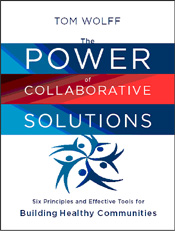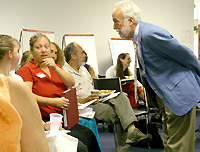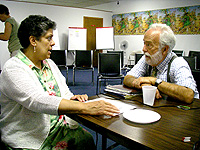Post election Collaborative Solutions Newsletter issue November 10, 2012
Posted by tomwolff in : Collaborative Solutions , add a commentDear Friends and Colleagues,
The Newsletter is Back!
And what timing……. the pundits have said it ‘ post-election America is in dire need of collaborative solutions’. So we all move forward in our work to build a ‘commons’ where we can address our differences and build exceptional healthy communities.
The Fall 2012 Issue of the “Collaborative Solutions Newsletter” from Tom Wolff & Associates is on “Managing Multiple Coalitions: Mission Possible”. In the newsletter I offer seven keys to successfully managing multiple coalitions.
This newsletter issue and earlier issues are available online at www.tomwolff.com. You may find that the web versions to be the easiest to read and download. A text version can be found below.
We encourage you to distribute this information. Please feel free to download this issue at www.tomwolff.com and circulate it to your friends and colleagues. You can subscribe for free at the end of the newsletter online. Let us know what you think and what else you would like to see in the newsletter.
Thanks
Tom Wolff
Tom Wolff & Associates
In this issue:
For Those Managing Multiple Coalitions: Mission Possible
The seven keys to success
- Site selection
- Orientation and ongoing training for teams
- Building a larger learning community
- Paying attention to leadership and membership
- Managing conflict
- Strategic planning and action
- Monitoring and creating systems of accountability
What is new at Tom Wolff & Associates
For Those Managing Multiple Coalitions: Mission Possible
In both public and private spheres, many foundations and agencies create and fund systems of independent coalitions working at various geographical sites on the same issue. For example, a state health department may wish to encourage the creation of local food and fitness coalitions. So the department issues an RfP and chooses twenty coalition applicants from across the state to be funded to implement the project. This is how big ideas can be spread across a state, a region, or even an entire nation.
As the people involved in setting up and managing multiple coalitions at many sites often discover this can quickly become a logistical and organizational nightmare
Over the last thirty years, I have frequently been asked to design, train, and consult with these kinds of multiple coalition systems. While the complexities can be challenging, the successful outcomes have been exhilarating for everyone involved.
A common “wisdom” of coalition success is the “Law of Thirds”: if you set up coalitions in every state in the country or every county in your state, one third will succeed, one third will struggle but make progress, and one third will fail. In fact, coalition outcomes often look like this. However, no one ever sets up their system of coalitions with such limited hopes. At the outset we all seek 100% success. So how do we surmount the common wisdom and achieve extraordinary results?
The consulting work I have done for numerous multiple-site coalition systems has helped people combine their forces to solve problems relating to an extremely broad range of topics. Here are a few examples of multiple-coalition systems that have asked me to facilitate their multifaceted efforts:
- The National Funding Collaborative on Violence Prevention (now the Institute for Community Peace) works with coalitions across the United States on a variety of forms of violence prevention and peace promotion.
- Healthy Communities Massachusetts was initiated by our own nonprofit, Community Partners, to build healthy community teams in cities and towns across Massachusetts.
- The Boston Public Health Commission’s Center for Health Equity and Social Justice’s REACH 2010 health-equity grant sites learned to work together through consultation and training.
- The Healthy Wisconsin Leadership Institute brings me in annually as a trainer and consultant to statewide teams.
- The Centers for Medicare and Medicaid Services End-Stage Renal Disease Networks brought me in for training and consultation, and over a few years we built the organizations’ capacity to develop regional coalitions on a number of critical topics, like disaster planning.
These are examples of multi-site coalition systems that have succeeded. As we have done this work universal dilemmas, lessons and tools have emerged that can be helpful for those designing and managing systems of multiple coalitions. These coalitions have succeeded by paying attention to seven key areas; these areas can make the difference between success and failure for multiple-site collaborations:
- Site selection
- Orientation and ongoing training for teams
- Building a larger learning community
- Paying attention to leadership and membership
- Managing conflict
- Strategic planning and action
- Monitoring and creating systems of accountability
Let’s look at the seven keys to success in more detail.
1. Selecting sites
Site selection generally occurs through an application process, the administrative body issues an RfP and asks coalitions/communities to express their interest in participating and to make a case for their group’s inclusion. This can give us more information for selection, but even when we carefully evaluate applicants all we can do is make our best guess about which groups will work well together, or even put out effort toward the goals. Little data seems to exist to predict how to choose good performing coalitions.
In evaluating applicants it is good to look for:
- A sense that the group understands the goals of the coalition.
- Some excitement from the group about engaging in the venture (just the fact that they have applied show some interest).
- Some competence within the applicant group in the content of the coalition work (i.e. food and fitness)
- A track record of getting results through coalition building.
- Lastly, a clear proposed plan to proceed.
Yet when we look back at the selected coalitions that later failed, the hints that would have let us predict the failure were not always evident in the applications. In one recent example, an applying coalition looked really competent in their application, but only wanted to get access to more money to promote its existing agenda and had no interest in the extra work that we were supporting. This self-serving purpose only became obvious after we had funded them.
2. Providing orientation
At the start of an initiative, orientation of new sites is critical. I have seen many variations of how orientation can be carried out.
Orientation is the time when the funder shares very clear expectations about what is expected from the participating coalitions. This is tricky. We often create coalitions because we want to create broad changes that require community input. By definition, our ideas have a large scope. The trick comes in allowing for this large scope and for community ownership and creativity, while still being clear about the specific outcomes that we intend to achieve.
We learned this the hard way, in the early years when our vision and optimism ran high and we had far less experience to let us look to the future and predict, and prevent problems. When we initially launched Healthy Communities Massachusetts in the early 1990s, the field was young and we were naïve, enthusiastic, and grandiose. So we left the specific goals vague, in terms of both content and process, in the hope of encouraging the participants’ creativity and ownership. We paid a price with the resulting chaos. In future rounds, we got better at setting expectations while encouraging community input—and our outcomes improved dramatically.
As we consult with other groups now, we see projects that err in both directions either by asking too much or too little of the collaborators at the start. From the obvious risks of “too little,” some funding authorities have moved toward “too much”. I now work with some groups where the funder dictates everything, down to the number of minutes committed to a meeting’s agenda items.
In many contemporary public health projects, we want to look at changing specific indicators in the context of the social determinants of health (SDOH). This is a very broad scope. So when we orient a group to achieve a goal like this, what specific objectives do we want to outline for them? If the coalitions feel they need to accomplish something concrete, they will focus on the indicator and ignore the social determinants. On the other hand, if they concentrate on a broad SDOH community assessment, they may find it hard to show concrete results.
Delicate balances like these can be resolved, but they require careful consideration before the initial orientation takes place.
3. Building a larger learning community
Building a learning community among the participating sites can be one of the most powerful tools for creating a network of successful coalitions. We often ignore the power of peer learning, and as a result we miss great opportunities.
It’s easier to build a larger learning community if you have time on your side. In some situations, we have had grants that have extended over two or three years. Sites had the opportunity to meet at gatherings, including annual trainings, where they could build relationships with each other and share their work. While we began with an expert/training model in early meetings, once some foundations had been established and work was underway it became apparent that the best learning was actually going to happen through the sites’ shared successes and struggles. That sharing had been part of the earliest trainings, but as the project evolved we were able to systematically focus on it. We designed whole meetings, led by team members, in which teams presented their experiences to each other and were paired up to coach each other.
4. Paying attention to leadership and ongoing training for leaders
Let’s consider leaders—both where they come from and what they do. We usually assume that coalitions will be facilitated by people well versed in the world of collaboration and organizational change. We envision these as folks who have been trained in community public health, community psychology, or community development. In fact, few people, even in these fields, have been trained to facilitate coalitions. As a result, coalition leaders come from varied backgrounds and what they have in common is interest and enthusiasm, not necessarily the skills. Thus, it is vital to provide training on many core coalition skills.
I recently trained two sets of coalition leaders at national meetings. The first group was developing statewide breast-feeding coalitions. This passionate group of women is committed to supporting policy change to encourage breast feeding. Most were lactation nurses who had, through a process of evolution, ended up as statewide coalition leaders. The second group consisted of IRS staff (yes, the Internal Revenue Service!) who work in a program that creates local collaborations to help low-income residents get free tax-form help (VITA program Volunteer Income Tax Assistance). These were mostly accountants by training with long histories of doing compliance work for the IRS. They had little to no experience at all with coalition work before they started. Yet, both sets of people were engaged in facilitating coalitions and were eager learners.
There’s no way to tell in advance whether your current coalition leadership is capable of delivering your desired results. No matter who you’re working with, you usually need a comprehensive leadership-training plan. There are lots of ways to accomplish this. For Healthy Communities Massachusetts, we held an annual three-day retreat for our community teams. In these three days, we covered the essentials: coalition building, grassroots community engagement, healthy communities, leadership, racial equity, and evaluation. We followed this up with shorter workshops throughout the year.
5. Preparing to manage conflict
Conflict is inevitable. One question to ask is whether you have adequate mechanisms for managing it.
Many individual coalitions get bogged down in poor facilitation and group processes. In fact, I have met many coalitions that do not even meet regularly! They fail to communicate, and are not clear on roles and responsibilities and decision-making processes. The literature indicates that one of the keys to getting these coalitions to be effective depends on identifying and managing conflict.
Once I was training coalition leaders in northern Minnesota and the discussion turned to the management of conflict. The group informed me that the norm in their area was to be “Minnesota nice,” so that addressing conflict would be a challenge. This is a cultural issue that reaches far beyond northern Minnesota, although the Minnesotans were kind enough to point it out. In truth, conflict-avoidance is often the norm in nonprofit coalitions, no matter where they are located.
For many groups, I suggest a very simple process that will help them address their internal “sticky” situations without frightening anyone. Start each meeting by creating ground rules, or by reviewing existing ground rules. Post these agreed-upon guidelines. An example would be “one person talks at a time.” Another, if there’s a particular member who talks too much, could be to suggest a limit placed any individual’s talking time on a single topic. At the end of each meeting, conclude by making a two column “plus/delta” list, looking for what worked about the meeting (the “plus” items) and what could have been different (the “delta,” or change, items). List the two categories on a newsprint sheet and have everyone contribute observations. In this way you can check as to whether you have respected your own guidelines. These two steps can help identify and address ongoing process issues.
6. Strategic planning and action
Here are some of key questions to ask regarding planning and action:
- Does the project have a vision that the participants have generated together?
More than once I have done training for a coalition that is 6 to 9 months old and has yet to develop a vision. Very easy visioning exercises can prevent this flailing about; see The Power of Collaborative Solutions p.157).
- Are the actions tied to the vision and the goals?
Logic models were developed to guarantee that a link exists between vision/goals and action, but the formal language of “logic model” can be scary for community groups. To get past this barrier see the Tearless Logic Model (http://www.gjcpp.org/en/index.php?issue=7)
- Is your organization converting its ideas into action or does it get stuck in the planning stage?
Many processes involving multiple coalitions begin with lengthy data-gathering phases and/or organizational structure demands (bylaws, 501(c)(3) requirements, incorporation, and so on). This can distract the people in the systems so much that they forget that they have to move to actual community actions in order to create community change.
- Most importantly, do outcomes matter?
The funding organization must make it clear that the whole purpose of these efforts is to create community change and that outcomes really do matter.
- Finally, are the project participants planning for sustainability?
There’s no point in doing the work only to have it fall apart just as it should be generating its own momentum. I have developed a four-pronged sustainability process that needs to be part of the project’s thinking right from the start. It involves finding resources, developing policies, creating community ownership, and institutionalization. http://www.gjcpp.org/en/index.php?issue=1. It’s a lot easier to build this in at the beginning than to realize, as you near the end of the road, that you are about to run out of pavement.
7. Monitoring and creating systems of accountability
Once we have created these multiple-site coalition systems how do we monitor their progress? What process and outcome measures do we look at to determine whether they’re accomplishing what we have asked them to? How do we build in encouragement for those coalitions that are working to create community change, and consequences for less productive performances?
Often we start with process measures: How often are the participants meeting? How many people attend, and who are they? Are there any members of the affected groups? Are the collaborators creating work groups to get the actual tasks done?
It’s more difficult to examine outcomes than processes, because many of these are long term. The work of Fawcett and colleagues suggests tracking and documenting the creation of community changes, which they defined as changes in programs, policies, and practices that will help people reach the desired long-term outcomes (see the Appendix in The Power of Collaborative Solutions). This can help you track progress. But in truth most coalition systems don’t use such specific criteria.
In the meantime, with informal monitoring going on but without clear evidence that their money is being well invested, program administrators have to decide which programs are progressing at an adequate rate; which need to be put on “probation”; and which to drop from their funding list. Sometimes, because measurement seems so hard, these decisions just get finessed and programs that are not performing continue to be funded and supported.
It would be helpful if the formal evaluation processes set up for these systems of coalitions could assess their effectiveness in ways that help funders base their decisions. Unfortunately, program evaluation is often contracted out to a third party and produces data that may be of little value for administrators deciding whether to continue supporting a coalition, or, worse, arrive so late that they are useless.
There are alternatives. Both accountability and performance measures can be built into the operation of the system from the start. Doing this is easier and more accurate than trying to work on these tasks retroactively, and has the strong added benefit of giving the participants ongoing feedback about the effectiveness of their work, which can strengthen their commitment and multiply the positive results of the entire project.
Mission possible: Tom Wolff & Associates can help your multiple-coalition effort.
Whew that’s a lot to keep track of! Designing and implementing a system of coalitions, at any scale, poses many questions. The good news is that technical assistance is available to help you prevent, or resolve, a wide range of problems that may impede the work of your multiple-coalition system.
Whether your responsibilities are focused across a state, a region, or a nation, Tom Wolff & Associates can help you design and sustain a coalition system of excellence that operates efficiently, remains on track, and achieves your desired goals.
Whether you’re just getting going or you’ve reached a point where you’re stuck, contact us at tom@tomwolff.com. It’s easier and more economical to set your system up for success than it is to watch your dreams fade. We can help you work together and achieve the results you envision.
What is new at Tom Wolff & Associates?
New clients at Tom Wolff & Associates:
Internal Revenue Service – Training for leaders covering the whole nation in VITA program IRS in the SPEC (Stakeholders, Partnerships, Education and Communication) division. August 2012
United States Breast Feeding Coalition (USBC) – Training for state leaders from all fifty states with an emphasis on concrete tools to take back home. August 2012
Western University of Health Sciences, College of Graduate Nursing. Keynote training for their conference on Quality and Safety Education for Nurse Educators and Clinical Leaders. Focus on how to build collaboration in increasing safety and quality in hospital care. August 2012.
Family Crisis Center of East Texas, Angelina County SAVE Coalition, Lufkin Texas: Day long retreat to launch sexual assault prevention coalition for the county. August 2012
Massachusetts Home Visiting Initiative – training for leaders from 17 statewide coalitions on early childhood intervention sponsored by the Massachusetts Dept. of Public Health with federal money from the new Health Care Bill. October 2012
Oklahoma State Health Department. Tobacco Settlement Endowment Trust Keynote workshop on Building Health Communities through Collaborative Solutions at statewide annual meeting. October 2012
The Power of Collaborative Solutions
The Power of Collaborative Solutions continues to do well, being adopted by more and more universities for course use. The book also was heavily referenced in Meredith Minkler’s wonderful third edition of “Community Organizing and Community Building for Health and Welfare”
Add a comment





